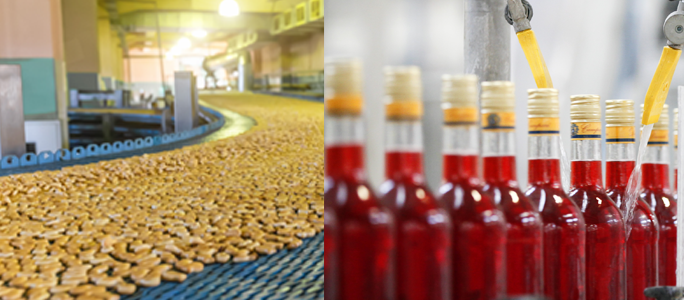
These are challenging times. Even though the pandemic is over the effect of it is still being felt by businesses of all sizes and types, all around the world.
As if the challenges of furious competition and thin margins to survive, among others, were not enough, the businesses now face renewed dynamics of customer expectations of both- innovative products and better quality.
While most industries have been left bleeding, one industry that has remained relatively unscathed by the pandemic is the food manufacturing sector.
COVID-19 has affected lives & livelihoods, and changed trends, but the link between mankind and food hasn’t weakened, and so, the industry has stayed strong.
The food manufacturing industry is vastly diverse, and can be classified into many sub industries such as bakery, meat & poultry, dairy, seafood, packaged food, etc.
The industry is unique, and so are each one of its sub-sectors.
And this uniqueness reflects in their processes.
Among many other reasons, the food industry and its micro-verticals are unique because of their unique requirements, and their unique processes.
To quote a few examples, the food industry is unique from many other industries in terms of variable catch weight products as against discrete piece counts, products with comparatively short shelf lives, and essentially inconsistent raw materials.
Other industries may have the luxury of consistent raw materials, where a piece is a piece, and product orders are typically based on piece counts.
But with some of food manufacturing industry’s segments, particularly meat & poultry, seafood, and dairy industry, it’s a different case altogether.
And in these industries, catch weight management comes into the picture.
What exactly is catch weight management?
In the food manufacturing industry, catch weight refers to the actual weight of a product that is sent to the buyer, and is usually used for managing products with variable weights; particularly for pricing of food products that vary in sizes, for example: products such as meats, steaks and seafood, blocks of cheese, fruits, and vegetables, and those that are typically sold in bulk.
Take, for instance, the chicken breasts. You may see that they are often sold in package of four.
However, these packages never cost the same, as they have different weights, and hence the different prices.
Selling them all at a uniform price may mean that once customer ends up with 23 ounces of chicken, and another with 26 ounces, for the same price.
That’s why, the packages are priced according to weight.
The catch weight products predominantly use two units of measure:
- Inventory unit: It refers to the unit of measure in which the product is sold, received, transferred, picked, and shipped.
- Catchweight unit: It refers to the unit by which the item is weighed and invoiced
Why catch weight management is important in food manufacturing?
In the food manufacturing industry, catch weight does not carry any implications for health and safety. However, as discussed above briefly, it does have implications for a manufacturers’ time and money.
It is relatively easier for the manufacturers to manage inventory like peanut butter, because there’s simply no change in its weight or price when a customer buys a single jar or five cases.
But for dairy, and meat manufacturers who are involved in business of blocks of cheese, and cuts of meat respectively, there’s a need to manage products with weight variability.
The cost of this type of items changes based on weight.
No two cases of beef, for example, will have the same weight, even if they have the same number of items.
One case could have bigger cuts and weigh more than the other.
Implications for businesses
If the manufacturers and processors price their items based on average weight, there would be times when the item would either be underweighted, or overweight.
If they constantly sell an underweight item, the customer might feel cheated. As a result, they might lose the customer for good, while their reputation may go for a toss.
If they sell products that are slightly overweight, the slight changes in weight may not seem significant to the naked eye.
But they will add up overtime, and when multiplied by the thousands of orders filled, result in huge losses! This has a huge impact on the cost of goods sold as well as overall profits, and this inconsistency in size calls for consistency in the calculation.
In any case, having proper catch weight management in place will help them avoid costly errors, which is why catch weight becomes important for products with variable weights.
What are the challenges of using catch weight?
Manufacturers have had fair bit of issues using catch weight, since they have invariably relied on manual way of doing it, which unsurprisingly is extremely labour-intensive, error prone, and requires the organizations to put huge costs into it.
Come to think of it; manufacturers hiring a person who stops the line to weigh and record the weight of every single package that comes off it using a pen and paper.
Not only does it create ground for human errors, but forces manufacturing organizations to invest massive amount of cost and time into tracking each weight manually.
Food manufacturers and processors who don’t want to lose time or money, need to find an alternative that offers a sustainable solution to this issue, and at the same time, saves their money and time.
An ERP software for food industry that offers catch weight management functionality happens to be that solution.
How can a food ERP help?
A food ERP software with catch weight management functionality can automate, and thus simplify, the task of accurately tracking and reporting inventory and sales of products that can vary in size.
It allows the manufacturers to record weights of units as they come off the line, and ensures they are properly labelled.
It also allows defining catch weight units and weight classes at every point in the supply chain, which further simplifies things for all the stakeholders- right from the wholesalers, distributors, retailers and right up to the end customer.
What an ERP also does is that by eliminating the human errors, it speeds up the process substantially.
Along with real-time inventory and sales tracking, it offers the processors capabilities such as catch weight processing, multiple units of measure, real-time yield management, and tracing.
A food ERP software with built-in catch weight management can have the following benefits:
- Automatic capture of weight data
- Dual unit of measure for storage, production, and sale
- Optimized use of materials
- Waste reduction
- No loss of profit due to inaccurate measurements
- No costly human errors
Conclusion-
Having a food manufacturing ERP software with catch weight management functionality is a must for food manufacturers. However, it must be noted that they shouldn’t rely on one-size-fits-all ERP.
Just as we spoke above how different sub-industries within the food industry have unique processes and requirements, the manufacturers should look for an ERP that’s tailor-made for their vertical.
At BatchMaster, we have extensive experience of serving different verticals of food industry such as the dairy, meat & poultry, and seafood among many others.
We have an in-house team of experts that specializes in setting up catch weight management functionality to best serve your needs.
Contact us to learn how BatchMaster ERP for Food can help you with catch weight management.




















